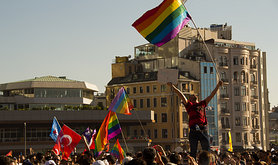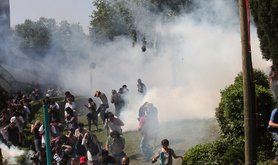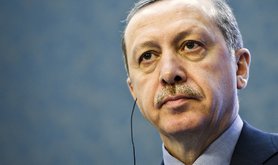On May 28 2013, a few hundred people gathered at Istanbul’s Gezi Park. They were there to protest the demolition of Taksim’s last remaining public park. The people gathered in the park were mostly environmental activists, leftists, and a few outspoken public figures; artists, musicians, actors-actresses. They had only one aim: to protect the trees in the park from being cut down (or ‘transferred to a more suitable spot’ as claimed by the government representatives) and to protest the planned construction of a replica of 19th century Ottoman Barracks in its place, which was to serve as a luxury residence and Istanbul’s 94th shopping mall. They could not have known that they were about to ignite the biggest civil protest movement Turkey has witnessed in the last three decades.
Learning about the standoff, more protesters surrounded the park on Wednesday May 29, only to be tear-gassed and pepper-sprayed by the police. That same day, Prime Minister Recep Tayyip Erdoğan made a public statement directed at the protestors: “We’ve already made up our mind about Gezi,” said the PM, “We’re going to demolish the park no matter what. Protest all you want—we won’t stop the demolition.” As could be expected, this did nothing but escalate the tension. People set up tents in the park and started taking turns to “guard the trees.” Still, at this point, the number of demonstrators was not yet a thousand.
What started as a peaceful protest on Tuesday might have come to an end in a few days if it weren’t for the police raid to the park at 5 am on Thursday, May 30 when officers pepper-sprayed and tear-gassed people sleeping in their tents and set some tents on fire. Things now started to get out of control. Outraged by the degree of police brutality, more and more people started flooding to Taksim Square. But this crowd was not the ‘usual suspects’; activists protesting the government’s increasing authoritarian policies. What set it apart was the presence of white-collar and wealthy Istanbulites, most of whom were attending a civil protest for the first time in their lives.
The next day, their numbers continued to swell. By Friday night, the heart of Istanbul’s night life, Taksim Square, normally full of people looking for entertainment, was full of people protesting police violence and defending Gezi Park. Istanbul was not the only city on the rise on Friday night. People in other big cities like Ankara, Izmir, Eskisehir, Diyarbakir, Adana, Antalya were all out in the streets to be met by excessive police reaction. What started off as a small protest against the demolition of a small park had, by this time, turned into a massive civil uprising against the government in which the most chanted slogans were “Down with the government!” and “Shoulder to shoulder against fascism!”
Meanwhile, the absolute silence about the events in the majority of Turkish News media continued, as mainstream TV channels continued to air soap operas, documentaries and entertainment programs. Those citizens following the clashes via social media and local and foreign news sites, however, started pouring into streets. People from distant neighborhoods on both the Asian and European sides of Istanbul started marching towards Taksim. Although police subjected thousands to gas and water canons and hundreds were injured—several of them severely—the number of protestors only kept increasing. Early on Saturday morning, at 6am, thousands of people from the Asian side halted traffic on the Bosphorus Bridge and crossed the bridge on foot, determined to join the Taksim protesters.
Saturday, June 1st, witnessed the biggest clashes between police and the protestors. Prime Minister Erdoğan again insisted on ignoring the public demands, saying, “The police were there (in Taksim) yesterday, they are there today, and they will be there tomorrow.” He then continued: “Even though the opposition gathered hundreds of thousands in Taksim, we could gather more than a million people if we wanted.” Meanwhile, Republican People’s Party (CHP)—the main opposition party in the parliament—announced that it would relocate a meeting planned in Istanbul’s Asian Kadıköy neighborhood and asked its members to walk to Taksim.
Then, at 5pm on Saturday, after hours of continuous clashes, the police started to withdraw from the square. The tens of thousands gathered at Taksim now managed to reclaim Gezi Park. Although many expected this to be the end of clashes, they soon realized that they were mistaken. At around 6pm, the police regrouped in the Beşiktaş neighborhood (just below Taksim). They began to attack groups of protestors and terrorize the neighborhood with massive amounts of gas and water. Clashes intensified throughout the night. Witnesses in Beşiktaş said that the police were gassing every single store, café, and apartment building on their way. As I write this on early Sunday morning, these clashes are continuing.
So what do the protesters want now? Although the demolition of a public park was the symbolic trigger for this uprising, the mass participation stems from a number of more complicated reasons. The protesters are the most heterogeneous opposition group Turkey has seen in the last two decades, including leftists, secular-nationalist Kemalists (mostly CHP voters), ultra-nationalists (mostly MHP voters), some Kurds (the Kurdish movement, concerned at the presence of Turkish ultra-nationalists in the crowd, has refrained from participating at full strength), some Islamists and some unaffiliated, apolitical citizens outraged by police brutality. That said, there is one issue that unites these different groups; anger at the AKP government’s increasingly oppressive, intolerant, authoritarian discourse, and Erdoğan’s arrogant statements belittling any opposition as “marginal groups.” Interpreting majoritarian democracy as ‘the tyranny of the majority’ and ignoring criticisms from opposition groups, Erdoğan believes that his 49 per cent of the national vote gives his party the right to pass any law he deems suitable.
Hence, each group has something to worry about. While the secular-nationalists are worried that the pro-Islamic AKP government is going to “turn Turkey into Iran,” they also share with the ultra-nationalists the fear that the peace talks between the AKP and the PKK (Kurdish Worker’s Party) will eventually “divide the country.” The leftists and the Kurdish opposition, on the other hand, are worried about the future of democracy as AKP government has increasingly cracked down on both groups, jailing more than 8,000 Kurdish politicians, and around 100 journalists and 600 students.
It would be unrealistic to claim that these protests will immediately topple Erdoğan. The battle for Gezi Parki has been and is still an unorganized uprising without solid political demands. However, these protests, taking place at the heart of Istanbul, have politicized a formerly apolitical section of the population and contributed to anti-AKP sentiment among different groups. If Erdoğan insists on ignoring these protestors and scolding them as “a few looters,” he may have to face even bigger protests in the near future.
Read more
Get our weekly email




Comments
We encourage anyone to comment, please consult the oD commenting guidelines if you have any questions.